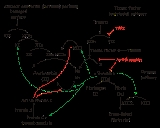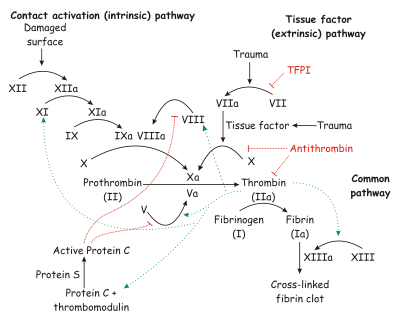
Factor XII
Encyclopedia
Coagulation factor XII also known as Hageman factor is a plasma protein
. It is the zymogen
form of factor XIIa, an enzyme
of the serine protease
(or serine endopeptidase) class. In humans, factor XII is encoded by the F12 gene
.
cascade and activates factor XI
and prekallikrein
. Factor XII itself is activated to factor XIIa by negatively charged surfaces, such as glass.
 In vivo, factor XII is activated by contact to polyanions. Activated platelets secrete inorganic polymers, polyphosphates. Contact to polyphosphates activates factor XII and initiates fibrin
In vivo, factor XII is activated by contact to polyanions. Activated platelets secrete inorganic polymers, polyphosphates. Contact to polyphosphates activates factor XII and initiates fibrin
formation by the intrinsic pathway of coagulation with critical importance for thrombus
formation.Targeting polyphosphates with phosphatases interfered with procoagulant activity of activated platelet
s and blocked platelet-induced thrombosis in mice. Addition of polyphosphates restored defective plasma clotting of Hermansky-Pudlak syndrome
patients, indicating that the inorganic polymer is the endogenous factor XII activator in vivo. Platelet polyphosphate-driven factor XII activation provides the link from primary hemostasis (formation of a platelet plug) with secondary hemostasis (fibrin meshwork formation).
for factor XII is located on the tip of the long arm of the fifth chromosome
(5q33-qter).
due to factor XII's role as one of the catalysts for conversion of plasminogen to its active fibrinolytic form of plasmin
.
Hageman factor is also activated by Endotoxin
, especially Lipid A
.
contributed to Hageman's death after an occupational accident. Since then, case series clinical studies identified an association between thrombosis
and Factor XII deficiency. Hepatocytes express blood coagulation factor XII.
Protein
Proteins are biochemical compounds consisting of one or more polypeptides typically folded into a globular or fibrous form, facilitating a biological function. A polypeptide is a single linear polymer chain of amino acids bonded together by peptide bonds between the carboxyl and amino groups of...
. It is the zymogen
Zymogen
A zymogen is an inactive enzyme precursor. A zymogen requires a biochemical change for it to become an active enzyme. The biochemical change usually occurs in a lysosome where a specific part of the precursor enzyme is cleaved in order to activate it...
form of factor XIIa, an enzyme
Enzyme
Enzymes are proteins that catalyze chemical reactions. In enzymatic reactions, the molecules at the beginning of the process, called substrates, are converted into different molecules, called products. Almost all chemical reactions in a biological cell need enzymes in order to occur at rates...
of the serine protease
Serine protease
Serine proteases are enzymes that cleave peptide bonds in proteins, in which serine serves as the nucleophilic amino acid at the active site.They are found ubiquitously in both eukaryotes and prokaryotes...
(or serine endopeptidase) class. In humans, factor XII is encoded by the F12 gene
Gene
A gene is a molecular unit of heredity of a living organism. It is a name given to some stretches of DNA and RNA that code for a type of protein or for an RNA chain that has a function in the organism. Living beings depend on genes, as they specify all proteins and functional RNA chains...
.
Function
Factor XII is part of the coagulationCoagulation
Coagulation is a complex process by which blood forms clots. It is an important part of hemostasis, the cessation of blood loss from a damaged vessel, wherein a damaged blood vessel wall is covered by a platelet and fibrin-containing clot to stop bleeding and begin repair of the damaged vessel...
cascade and activates factor XI
Factor XI
Factor XI or plasma thromboplastin antecedent is the zymogen form of factor XIa, one of the enzymes of the coagulation cascade. Like many other coagulation factors, it is a serine protease. In humans, Factor XI is encoded by the F11 gene....
and prekallikrein
Prekallikrein
Prekallikrein , also known as Fletcher factor, is a 85,000 Mr serine protease that complexes with High-molecular-weight kininogen. PK is the precursor of plasma kallikrein, which is a serine protease that activates kinins. PK is cleaved to produce kallikrein by activated Factor XII . -...
. Factor XII itself is activated to factor XIIa by negatively charged surfaces, such as glass.

Fibrin
Fibrin is a fibrous, non-globular protein involved in the clotting of blood. It is a fibrillar protein that is polymerised to form a "mesh" that forms a hemostatic plug or clot over a wound site....
formation by the intrinsic pathway of coagulation with critical importance for thrombus
Thrombus
A thrombus , or blood clot, is the final product of the blood coagulation step in hemostasis. It is achieved via the aggregation of platelets that form a platelet plug, and the activation of the humoral coagulation system...
formation.Targeting polyphosphates with phosphatases interfered with procoagulant activity of activated platelet
Platelet
Platelets, or thrombocytes , are small,irregularly shaped clear cell fragments , 2–3 µm in diameter, which are derived from fragmentation of precursor megakaryocytes. The average lifespan of a platelet is normally just 5 to 9 days...
s and blocked platelet-induced thrombosis in mice. Addition of polyphosphates restored defective plasma clotting of Hermansky-Pudlak syndrome
Hermansky-Pudlak syndrome
Hermansky–Pudlak syndrome is a rare autosomal recessive disorder which results in oculocutaneous albinism , bleeding problems due to a platelet abnormality , and storage of an abnormal fat-protein compound .There are eight classic forms of the disorder, based on the genetic mutation...
patients, indicating that the inorganic polymer is the endogenous factor XII activator in vivo. Platelet polyphosphate-driven factor XII activation provides the link from primary hemostasis (formation of a platelet plug) with secondary hemostasis (fibrin meshwork formation).
Genetics
The geneGene
A gene is a molecular unit of heredity of a living organism. It is a name given to some stretches of DNA and RNA that code for a type of protein or for an RNA chain that has a function in the organism. Living beings depend on genes, as they specify all proteins and functional RNA chains...
for factor XII is located on the tip of the long arm of the fifth chromosome
Chromosome
A chromosome is an organized structure of DNA and protein found in cells. It is a single piece of coiled DNA containing many genes, regulatory elements and other nucleotide sequences. Chromosomes also contain DNA-bound proteins, which serve to package the DNA and control its functions.Chromosomes...
(5q33-qter).
Role in disease
Factor XII deficiency does not contribute to bleeding, as in vivo it plays little part in clot formation (the intrinsic pathway instead being activated mostly at factor XI by thrombin generated by the extrinsic pathway) but can predispose towards greater risk of venous thrombosisVenous thrombosis
A venous thrombosis is a blood clot that forms within a vein. A venous thrombosis is a blood clot that forms within a vein. A venous thrombosis is a blood clot that forms within a vein. (Thrombosis is a medical term for blood clotting (Haemostasis) occurring in the wrong place, i.e...
due to factor XII's role as one of the catalysts for conversion of plasminogen to its active fibrinolytic form of plasmin
Plasmin
Plasmin is an important enzyme present in blood that degrades many blood plasma proteins, most notably, fibrin clots. The degradation of fibrin is termed fibrinolysis. In humans, the plasmin protein is encoded by the PLG gene.- Function :...
.
Hageman factor is also activated by Endotoxin
Endotoxin
Endotoxins are toxins associated with some Gram-negative bacteria. An "endotoxin" is a toxin that is a structural molecule of the bacteria that is recognized by the immune system.-Gram negative:...
, especially Lipid A
Lipid A
Lipid A is a lipid component of an endotoxin held responsible for toxicity of Gram-negative bacteria. It is the innermost of the three regions of the lipopolysaccharide molecule, and its hydrophobic nature allows it to anchor the LPS to the outer membrane...
.
History
Hageman factor was first discovered in 1955 when a routine preoperative blood sample of the 37-year-old railroad brakeman John Hageman (1918) was found to have prolonged clotting time in test tubes, even though he had no hemorrhagic symptoms. Hageman was then examined by Dr. Oscar Ratnoff who found that Mr. Hageman lacked a previously unidentified clotting factor. Dr. Ratnoff later found that the Hageman factor deficiency is an autosomal recessive disorder, when examining several related people who had the deficiency. Paradoxically, pulmonary embolismPulmonary embolism
Pulmonary embolism is a blockage of the main artery of the lung or one of its branches by a substance that has travelled from elsewhere in the body through the bloodstream . Usually this is due to embolism of a thrombus from the deep veins in the legs, a process termed venous thromboembolism...
contributed to Hageman's death after an occupational accident. Since then, case series clinical studies identified an association between thrombosis
Thrombosis
Thrombosis is the formation of a blood clot inside a blood vessel, obstructing the flow of blood through the circulatory system. When a blood vessel is injured, the body uses platelets and fibrin to form a blood clot to prevent blood loss...
and Factor XII deficiency. Hepatocytes express blood coagulation factor XII.
External links
- The MEROPSMeropsMerops may refer to:* Merops , a genus of bee-eaters.* MEROPS, an on-line database for peptidases.It may also refer to several figures from Greek mythology:* King of Ethiopia, husband of Clymene, who lay with Helios and bore Phaethon...
online database for peptidases and their inhibitors: S01.211

